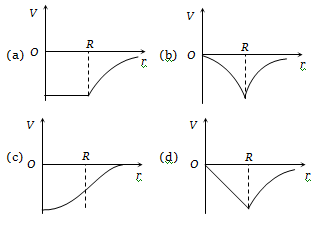A mass M is split into two parts, m and (M–m), which are then separated by a certain distance. What ratio of m/M maximizes the gravitational force between the two parts
1. 1/3
2. 1/2
3. 1/4
4. 1/5
Two identical satellites are at R and 7R away from the earth surface, the wrong statement is (R = Radius of the earth)
1. Ratio of total energy will be 4
2. Ratio of kinetic energies will be 4
3. Ratio of potential energies will be 4
4. Ratio of total energy will be 4 but ratio of potential and kinetic energies will be 2
A body of mass m is taken from earth's surface to the height h equal to the radius of the earth, the increase in potential energy will be:
1. mgR
2. mgR
3. 2mgR
4. mgR
1.
2.
3.
4.
Two bodies of masses and are initially at rest at infinite distance apart. They are then allowed to move towards each other under mutual gravitational attraction. Their relative velocity of approach at a separation distance r between them is
1.
2.
3.
4.
The period of the moon’s rotation around the earth is nearly 29 days. If the moon’s mass were 2 fold of its present value and all other things remained unchanged, the period of moon’s rotation would be nearly:
1.
2.
3.
4. 29 days
The distance of a planet from the sun is 5 times the distance between the earth and the sun. The time period of the planet is -
1. years
2. years
3. years
4. years
The diagram showing the variation of the gravitational potential of the earth with distance r from the centre of the earth is:
In planetary motion the areal velocity of position vector of a planet depends on angular velocity and the distance of the planet from Sun (r). If so the correct relation for areal velocity is -
1.
2.
3.
4.
A sphere of mass M and radius R2 has a concentric cavity of radius R1 as shown in figure. The force F exerted by the sphere on a particle of mass m located at a distance r from the centre of sphere varies as .








